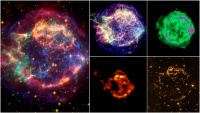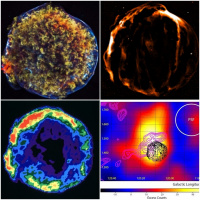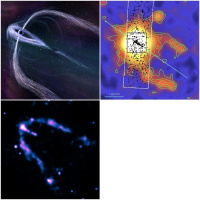Reach for the Stars/Stars and DSOs
The Reach for the Stars Star and DSO lists specify which stars and Deep Sky Objects are covered in the event in a particular year. Teams are expected to be able to identify these objects on star charts, HR diagrams (where applicable), planetariums (where applicable), or other forms of display. Teams should also be knowledgeable about the evolutionary stages of these stars and objects.
Stars
These are the stars from the 2020-2021 list (not in alphabetical order). With multiple-star systems, the Apparent/Absolute Magnitude is the combined Apparent/Absolute Magnitude of the stars:
| Name | Images | Spectral Type | Constellation | Magnitude | Distance | Coordinates | ||
|---|---|---|---|---|---|---|---|---|
| Apparent | Absolute | Right Ascension | Declination | |||||
| Altair | 
|
A7V | Aquila | 0.76 | 2.22 | 16.73 ly | 19h 50m 47s | +08° 52′ 06″ |
| Altair is a main sequence star in the constellation Aquilla, and makes up one of the stars in the Summer Triangle. This Delta Scuti variable star has a such a high rate of rotation that its equatorial diameter is significantly larger than its polar diameter. Additionally, it exhibits luminosity pulsations between 0.8 and 1.5 hours. A mere 16.7 light years away, this star is visible without the aid of telescopes or other equipment. | ||||||||
| Capella | 
|
K0III/G1III | Auriga | 0.08* | -0.48 | 42.9ly | 05h 16m 41s | +45° 59′ 53″ |
| RS CVn Variable Star, a close binary system whose apparent magnitude varies from +0.03 to +0.16. | ||||||||
| Arcturus | 
|
K0III | Boötes | -0.05 | -0.30 | 36.7 ly | 14h 15m 40s | +19° 10′ 56″ |
| Red giant star. | ||||||||
| Sirius | 
|
A1Vm/DA2 | Canis Major | -1.46 | 1.42 | 8.60 ly | 06h 45m 09s | −16° 43′ 06″ |
| Brightest star in the night sky. A binary system with Sirius A, a main sequence star, and Sirius B, a white dwarf with Apparent Magnitude 8.44 and Absolute Magnitude 11.18. The name "Sirius" is derived from the Ancient Greek "Seirios", meaning "glowing" or "scorcher". | ||||||||
| Procyon | 
|
F5IV-V | Canis Minor | 0.34 | 2.66 | 11.5 ly | 07h 39m 18s | +05° 13′30″ |
| Main sequence star with faint white-dwarf companion. | ||||||||
| Deneb | 
|
A2Ia | Cygnus | 1.25 | -8.38 | 802 ± 66 pc | 20h 41m 25.9s | +45° 16′ 49″ |
| Blue-white Supergiant. | ||||||||
| Castor | 
|
Gemini | 51 ly | 07h 34m 36s | +31° 53′ 18″ | |||
| Triple Star system. | ||||||||
| Pollux | K0III | Gemini | 1.14 | 1.08 | 33.8 ly | 07h 45m 19s | +28° 01′ 34″ | |
| Giant star. | ||||||||
| Vega | 
|
A0Va | Lyra | -0.02-0.07 (0.026) | +0.582 | 25 ly | 18h 36m 56s | +38° 47′ 01″ |
| Suspected Delta Scuti Variable. Northern pole star around 12,000 BC. | ||||||||
| Zeta Ophiuchi | 
|
O9.5 V | Ophiuchus | 2.57 | -4.2 | 366 ly | 16h 37m 10s | –10° 34′ 02″ |
| Blue main-sequence star at the start of its life. | ||||||||
| Betelgeuse | 
|
M1-M2 Ia-ab | Orion | -5.85 | 643 ± 146 ly | 05h 55m 10s | +07° 24′ 25″ | |
| Semiregular Variable Star. | ||||||||
| Rigel | B8 Ia | Orion | 0.13 | -7.84 | 860 ± 80 ly | 05h 14m 32s | −08° 12′ 06″ | |
| Blue Supergiant with Blue main-sequence companion. | ||||||||
| Algol | 
|
B8V/K0IV | Perseus | 2.12 | -0.07 | 90 ± 3 ly | 03h 08m 10s | +40° 57′ 20.3280″ |
| Multiple star system with a pair of eclipsing Variable stars. Counter-intuitively, the lower-mass star is leaving the main-sequence earlier. | ||||||||
| Antares | 
|
M1.5Iab+B2.5V | Scorpius | 0.6-1.6 | -5.28 | 550 ly | 16h 29m 24.5s | −26° 25′ 55″ |
| Red Supergiant with Orange main-sequence star companion. | ||||||||
| Aldebaran | 
|
K5III | Taurus | -0.86 | -0.64 | 65ly | 04h 35m 55s | +16° 30′ 33.5″ |
| Orange Giant Star. | ||||||||
| Mizar | 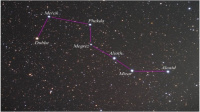
|
A2Vp | Ursa Major | 2.27 | 0.33 | 86 ± 4 ly | 13h 23m 55.5s | +54° 55′ 31″ |
| Visual double with Alcor. | ||||||||
| Alcor | A5Vn | Ursa Major | 3.99 | 2.00 | 81.6 ly | 13h 25m 13.5s | +54° 59′ 17″ | |
| Visual double with Mizar. | ||||||||
| Polaris | 
|
F7Ib/F6V | Ursa Minor | 1.98 | -3.6 | 323-433 ly | 02h 31m 49.1s | +89° 15′ 50.8″ |
| Current Northern pole star; Multiple Star system with Yellow Supergiant orbiting a smaller companion; Cepheid Variable star. | ||||||||
| Spica | 
|
B1 III-IV/B2 V | Virgo | 0.97 | -3.55 | 250±10 ly | 13h 25m 11.6s | −11° 09′ 40.8″ |
| Binary star system with a blue giant (beta cepheid variable) and a blue main-sequence star; a spectroscopic binary and rotating ellipsoidal variable; 22400 Kelvin. | ||||||||
Deep Sky Objects
These are the Deep Sky Objects (DSOs) from the 2021 list, not in alphabetical order. Each combined image often contains the DSO in multiple wavelengths, sometimes examining different sections of the object. Information about the individual images can be found by clicking on the combined image.
| Name | Images | Object Type | Constellation | Apparent Magnitude | Distance | Coordinates | Links | ||
|---|---|---|---|---|---|---|---|---|---|
| Right Ascension | Declination | ||||||||
| M31 (Andromeda Galaxy) | 
|
Type Sb spiral galaxy | Andromeda | 3.44 | 2.54 Mly | 00h 42m 44.3s | +41° 16′ 9″ | ||
| M31 is a galaxy that is part of the Local Group. It is the closest major galaxy to the Milky Way, and will likely collide with the Milky Way in around 4.5 billion years. | |||||||||
| DLA8017g (Wolfe Disk Galaxy) | 
|
Rotating Disk Galaxy | Cancer | 12.276 Gly, 3.764 Gpc | 08h 17m 40.86s | +13° 51' 38.2" | NRAO | ||
| DLA0817g is the oldest and farthest known disk galaxy, discovered by ALMA. | |||||||||
| NGC 5128 (Centaurus A) | 
|
Active Galaxy | Centaurus | 10-16 Mly (3-5 Mpc) | 13h 25m 27.6s | −43° 01′ 09″ | Chandra | ||
| THis is the closest active galaxy to Earth, and is apparently the result of a collision of two normal galaxies, as seen by the mixed star clusters and dust lanes. | |||||||||
| NGC 4676 (Mice Galaxies) | 
|
Colliding Galaxies | Coma Berenices | 14.7 | 290 Mly, 89 Mpc | 12h 46m 10.1s | +30° 43′ 55″ | ||
| The mice galaxies are two colliding spiral galaxies. They have long tidal tails, referenced by their name. | |||||||||
| NGC 4555 | 
|
Elliptical Galaxy | Coma Berenices | 13.1 | 310 Mly | 12h 35m 41.20s | Dec +26° 31' 23.20" | Chandra | |
| NGC 4555 is an isolated Elliptical Galaxy, embedded in a cloud of extremely hot gas that is significantly larger than it. The mass of the luminous matter in the galaxy seems far too small for the gas cloud to be held together, however, and astronomers have determined that this object must have a dark matter halo. | |||||||||
| NGC 4308 | 
|
Elliptical Galaxy | Corvus | 14.4 | 12.84 +/- 0.96 Mpc | 12h 21m 56.9s | +30° 04′ 27″ | ||
| NGC 4308 is an elliptical galaxy, and a member of the Coma I Group. | |||||||||
| NGC 4309 | 
|
Lenticular Galaxy | Corvus | 13.6 | 54 Mly (16.6 Mpc) | 12h 22m 12.4s | 07° 08′ 40″ | ||
| NGC 4209 is a lenticular galaxy in the Virgo cluster that is classified as an AGN. It has undergone Ram-pressure stripping, or the loss of its interstellar medium (the gas and dust between stars) due to moving through intracluster medium (the hot gas in between galaxies). | |||||||||
| Dragonfish Nebula | 
|
Emission Nebula/Star-Forming Region | Crux | 30 Kly | 12h 11m 27.5s | −62° 55′ 10″ | NASA | ||
| The Dragonfish Nebula is nearly invisible in optical light, as there is a large amount of dust obscuring it. However, in infrared, this massive star-forming region can be seen, as dust is invisible in infrared. The "mouth" of this nebula was formed from strong stellar winds of young, massive stars blowing a bubble in the gas and dust. This nebula might contain some of the brightest and most massive stars in the Milky Way galaxy. | |||||||||
| 30 Doradus (Tarantula Nebula) | 
|
H II Region | Dorado | 8 | 160 ± 10 kly | 05h 38m 38s | −69° 05.7′ | [1] [2] [3] | |
| Also known as the Tarantula Nebula. It is found in the Large Magellanic Cloud (LMC) and has a magnitude of 8. | |||||||||
| Large Magellanic Cloud (LMC) | 
|
Galaxy | Dorado/Mensa | 0.9 | 163.0 kly | 05h 23m 34.5s | −69° 45′ 22″ | ||
| A satellite galaxy of our Milky Way. The first mention of the galaxy was by Persan Astronomer 'Abd ar-Rahman as-Sufi around 964 AD, while Magellan observed it in 1519. | |||||||||
| Rho Ophiuchi Cloud Complex | 
|
Dark Nebula | Ophiuchus | 460 ly (140 pc) | 16h 28m 06s | –24° 32.5′ | APOD, APOD, APOD, and APOD | ||
| Rho Ophiuchi Cloud Complex is a dark nebula, and one of the closest star-forming regions to the Solar System. The first brown dwarf ever to be found in a star-forming region was found in Rho Ophiuchi Cloud Complex. | |||||||||
| M42 (Orion Nebula) | 
|
Diffuse Nebula | Orion | 4.0 | 1,344±20 ly | 05h 35m 17.3s | −05° 23′ 28″ | ||
| Contains a very young open cluster known as the Trapezium. | |||||||||
| NGC 1333 | 
|
Reflection Nebula | Perseus | 5.6 | 967 ly (296.5 pc) | 03h 29m 11.3s | +31° 18′ 36″ | NASA, APOD, Spitzer | |
| NGC 1333 is a reflection nebula, where starlight is reflected by interstellar dust. It currently contains hundreds of stars less than a million years old. | |||||||||
| Sagittarius A* | 
|
Black Hole | Sagittarius | Radio | ~7860 pc | 17h 45m 40s | −29° 0′ 28″ | ||
| Radio source at the center of a galaxy, and location of a supermassive black hole. | |||||||||
| M8 (Lagoon Nebula) | 
|
H II Region | Sagittarius | 6 | 4100 ly | 18h 03m 37s | −24° 23′ 12″ | ||
| Interstellar Cloud. | |||||||||
| Baby Boom Galaxy | 
|
Starburst Galaxy | Sextans | 12.2 Gly | 10h 00m 54.52s | +2° 34′ 35.17″ | Spitzer | ||
| The Baby Boom Galaxy is the record-holder for the brightest starburst galaxy (rapidly star-forming galaxy). It is forming stars at a rate of 4000 new stars per year (in comparison to the Milky Way's ~10 per year), and is thought to be a result of colliding galaxies. | |||||||||
| NGC 6357 (Lobster Nebula) | 
|
Emission Nebula | Scorpius | ~5900±450 ly (1800±140 pc) | 17h 24m | −34° 20 | NASA, NASA, APOD, Chandra | ||
| The lobster nebula is an emission nebula currently forming massive stars. | |||||||||
| NGC 6334 (Cat's Paw Nebula) | 
|
Emission Nebula | Scorpius | 5.54±0.98 kly (1.7±0.3 kpc) | 17 20 50.9h | −36° 06′ 54″ | |||
| NGC 6334 is known as the Cat's Paw Nebula and Bear Claw Nebula for its paw-like shape. It has several star-forming regions, four of which have formed HII regions. | |||||||||
| T Tauri | 
|
Variable Star | Taurus | 10.27 | ~600 ly | 04h 21m 59.43s | +19° 32′ 06.42″ | ||
| The prototype of all T Tauri variable stars. It was discovered in October 1852 by John Russell Hind. T Tauri appears from Earth amongst the Hyades cluster, but is actually 420 light years behind it and was not formed with the rest of them. T-Tauri stars have similar temperature compared to the main sequence star they will become, but are larger and therefore more luminous. They will follow the Hayashi Track onto the main sequence. | |||||||||
| Small Magellanic Cloud (SMC) | 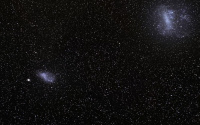
|
Galaxy | Tucana and Hydrus | 2.7 | 200±9 kly | 00h 52m 44.8s | −72° 49′ 43″ | ||
| Dwarf galaxy near the Milky Way. It was once a barred spiral galaxy, but was dirupted by the gravity of the Milky Way. | |||||||||
| GN-z11 | 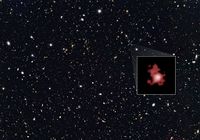
|
Distant Galaxy | Ursa Major | 25.8 | 32 billion ly (9.8 billion pc) | 12h 36m 25.46s | +62° 14′ 31.4″ | ||
| GN-z11 can be found in the Great Observatories Origins Deep Survey (GOODS) northern hemisphere field. It is the farthest galaxy ever observed, and is full of blue, young stars. It appears red because of its enourmous redshift (stretching of light to longer wavelenths), caused by a very high recessional velocity (or it is moving away from us really quickly). | |||||||||
| M101 (Pinwheel Galaxy) | 
|
Spiral Galaxy | Ursa Major | 7.86 | 20.9±1.8 Mly (6.4±0.5 Mpc) | 14h 03m 12.6s | +54° 20′ 57″ | NASA, Hubble | |
| M101 is a spiral galaxy around 70% larger than the Milky Way, with an unusually high number of HII regions, indicating a high rate of star formation. | |||||||||
| M60 | 
|
Elliptical Galaxy | Virgo | 9.8 | 56.7 Mly (17.38 Mpc) | 12h 43m 39.6s | +11° 33′ 09.40″ | ||
| Messier 60 is an elliptical galaxy with an inactive supermassive black hole at the center, which is one of the largest (but not the largest) supermassive black holes ever discovered. | |||||||||
| M104 (Sombrero Galaxy) | 
|
Lenticular Galaxy | Virgo | −21.8 | 9.55 ± 0.31 Mpc
(31.1 ± 1.0 Mly) |
12h 39m 59.4s | −11° 37′ 23″ | ||
| M60, or the Sombrero Galaxy, is a lenticular galaxy with an unusually bright, large nucleus and central bulge, and a dust lane that surrounds the outside of the disk. | |||||||||
Past Objects
Objects which previously were included in the list, but have been replaced, are provided here.
Stars
2011-2012
Gliese 581- Gliese 581 is a red dwarf, M3V star about 20 LY away. The star has an apparent magnitude between 10.56 and 10.58 and is located in the constellation Libra. The star is well known for its planet Gliese 581 g, thought to be in the habitable zone of its star, but the planet's existence is disputed. Mira (o Ceti)- The famous variable star Mira is located on the "tale" of Cetus. It is a binary star, with the red giant Mira A and its companion Mira B. Nearly 7000 other stars are classified with the variable type "Mira", named after the star. The star fluctates between apparent magnitude 2.0 all the way down to the faint 10.1 magnitude. Mira is a red giant star with the spectral type M7. Recently, astronomers have been studying the transport of gases nearly 70 AU from Mira A to Mira B. Proxima Centauri- At only 4 light years, Proxima centauri is the nearest star to the sun. It is a type-M red dwarf star, and despite its distance, it is too dim to see with the naked eye, at magnitude 11.05. Proxima Centauri is part of a triple star system with its brighter neighbor Alpha Centauri A and B. It is a flare star, a variable type that changes brightness drastically. |
Deep Sky Objects
2016-2017
| ||||||||||||||||||||||||||||||||||||||||||||||||||||||||||||||||||||||||||||||||||||||||||||||||||||||||||||||||||||||||||||||||||||||||||||||||||||||||||||||||||||||||||||||||||||||||||||||||||||||||||||||||||||||||||
2011-2012
Andromeda Galaxy (M31, NGC 224)- About 2.5 million LY away, the Andromeda Galaxy is the closest spiral galaxy to the Milky Way. In fact, it is one of the relatively few galaxies that are approaching the Sun, causing the light from its 1 trillion stars to be blue-shifted. With an apparent magnitude of 4.4, it's one the brightest Messier objects in the nighttime sky. The Andromeda Galaxy has a double nucleus: P1, a brighter nucleus with lots of reddish, cool stars, and P2, a supermassive black hole at the very center of the galaxy with more bluish, hotter stars. There was one recorded supernova in 1885. The name comes from the fact that the Andromeda Galaxy appear to be in the constellation Andromeda from our vantage point on Earth. Beehive Cluster (M44, Praesepe (Latin: manger), NGC 2632)- An open cluster in the constellation Cancer- possibly of similar origin to the Hyades- the Beehive Cluster is about 600 million years old. It spans 510-620 LY across, with big bright stars towards the center of the cluster and smaller, dimmer stars on the outside fringes. M44 contains red giants, main sequence stars, and white dwarfs; about 68% of the stars are M-class, 30% F, G, or K-class, and about 2% A-class. The brightest individual stars have an apparent magnitude of about 6 to 6.5, while the Beehive Cluster as a whole is about 3.1. Cassiopeia B (Tycho's SNR)- A supernova remnant, left over from a supernova detected in November 1572 which remained highly visible for 2 years, then faded. The supernova resulted from a white dwarf accumulating too much matter and exploding. It is called Tycho's SNR after the astronomer Tycho Brahe, who was the most accurate observer of the supernova itself. Globular Cluster (M13, NGC 6205)- A globular cluster (hence the name) about 25,100 LY away and 145 LY across in the constellation Hercules. M13 has several hundred thousand stars, but is barely visible from Earth, with an apparent magnitude of 5.8. Its brightest star is V11, which has an apparent magnitude of 11.95. Hyades Star Cluster- The Hyades are the closest open cluster to us at 151 LY away, located in the constellation Taurus. The 4 brightest stars in the Hyades (formerly A-class stars, now off the main sequence) form a V shape along with Aldebaran. It could share a common origin with the Beehive Cluster (M44). The name is from ancient Greek mythology- Hyades was the collective name of several weeping sisters who were turned into stars and therefore associated with rain. Milky Way Galaxy ("The Galaxy")- A barred spiral galaxy in the Local Group (which, in turn, is in the Virgo Supercluster) about 100,000 LY in diameter and 1,000 LY thick. Of the 200-400 billion stars in this galaxy, most are red dwarfs. The oldest ones are 12.8-14.4 billion years old. The galactic center is in the general direction of the constellation Sagittarius- in fact, Sagittarius A* is a supermassive black hole at the center of the Milky Way. It could collide with the Andromeda Galaxy in 3-4 billion years. The Milky Way can be seen as far north as Cassiopeia and as far south as Crux (the Southern Cross). Pleiades (M45, Maia Nebula)- Another open cluster in the constellation Taurus; one of the closest to Earth at about 440 LY away. Most of the stars in M45 are hot, blue stars formed in the last 100 million years or so, but there are also some brown dwarfs. The cluster will survive for about another 250 million years, then be dispersed by gravity. The name Pleiades is from Greek for either "sailing ones", "many", or "flock of doves". Whirlpool Galaxy (M51, NGC 5194)- A red-shifted galaxy (moving farther away from the Sun) in the constellation Canes Venatica about 23 million LY away, the Whirlpool Galaxy is famous for its distinct spiral shape. This is thought to be caused by interaction between M51 and a nearby galaxy, NGC 5195. There is also thought to be a black hole at the very center of the galaxy. In 2005, a supernova was detected in the Whirlpool Galaxy with highest apparent magnitude 14. |






